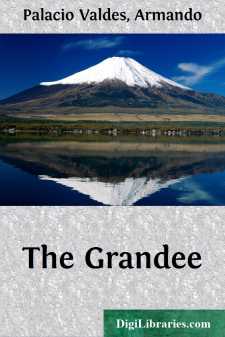Categories
- Antiques & Collectibles 13
- Architecture 36
- Art 48
- Bibles 22
- Biography & Autobiography 813
- Body, Mind & Spirit 142
- Business & Economics 28
- Children's Books 17
- Children's Fiction 14
- Computers 4
- Cooking 94
- Crafts & Hobbies 4
- Drama 346
- Education 46
- Family & Relationships 57
- Fiction 11829
- Games 19
- Gardening 17
- Health & Fitness 34
- History 1377
- House & Home 1
- Humor 147
- Juvenile Fiction 1873
- Juvenile Nonfiction 202
- Language Arts & Disciplines 88
- Law 16
- Literary Collections 686
- Literary Criticism 179
- Mathematics 13
- Medical 41
- Music 40
- Nature 179
- Non-Classifiable 1768
- Performing Arts 7
- Periodicals 1453
- Philosophy 64
- Photography 2
- Poetry 896
- Political Science 203
- Psychology 42
- Reference 154
- Religion 513
- Science 126
- Self-Help 84
- Social Science 81
- Sports & Recreation 34
- Study Aids 3
- Technology & Engineering 59
- Transportation 23
- Travel 463
- True Crime 29
The Grandee
Description:
Excerpt
INTRODUCTION
According to the Spanish critics, the novel has flourished in Spain during only two epochs—the golden age of Cervantes and the period in which we are still living. That unbroken line of romance-writing which has existed for so long a time in France and in England, is not to be looked for in the Peninsula. The novel in Spain is a re-creation of our own days; but it has made, since the middle of the nineteenth century, two or three fresh starts. The first modern Spanish novelists were what are called the walter-scottistas, although they were inspired as much by George Sand as by the author of Waverley. These writers were of a romantic order, and Fernan Caballero, whose earliest novel dates from 1849, was at their head. The Revolution of September, 1868, marked an advance in Spanish fiction, and Valera came forward as the leader of a more national and more healthily vitalised species of imaginative work. The pure and exquisite style of Valera is, doubtless, only to be appreciated by a Castilian. Something of its charm may be divined, however, even in the English translation of his masterpiece, Pepita Jiménez. The mystical and aristocratic genius of Valera appealed to a small audience; he has confided to the world that when all were praising but few were buying his books.
Far greater fecundity and a more directly successful appeal to the public, were, somewhat later, the characteristics of Perez y Galdos, whose vigorous novels, spoiled a little for a foreign reader by their didactic diffuseness, are well-known in this country. In the hands of Galdos, a further step was taken by Spanish fiction towards the rejection of romantic optimism and the adoption of a modified realism. In Pereda, so the Spanish critics tell us, a still more valiant champion of naturalism was found, whose studies of local manners in the province of Santander recall to mind the paintings of Teniers. About 1875 was the date when the struggle commenced in good earnest between the schools of romanticism and realism. In 1881 Galdos definitely joined the ranks of the realists with his La Desheredada. An eminent Spanish writer, Emilio Pardo Bazan, thus described the position some six years ago: "It is true that the battle is not a noisy one, and excites no great warlike ardour. The question is not taken up amongst us with the same heat as in France, and this from several causes. In the first place, the idealists with us do not walk in the clouds so much as they do in France, nor do the realists load their palette so heavily. Neither school exaggerates in order to distinguish itself from the other. Perhaps our public is indifferent to literature, especially to printed literature, for what is represented on the stage produces more impression."
This indifference of the Spanish reading public, which has led a living novelist to declare that a person of good position in Madrid would rather spend his money on fireworks or on oranges than on a book, has at length been in a measure dissipated by a writer who is not merely admired and distinguished, but positively popular, and who, without sacrificing style, has conquered the unwilling Spanish public....


